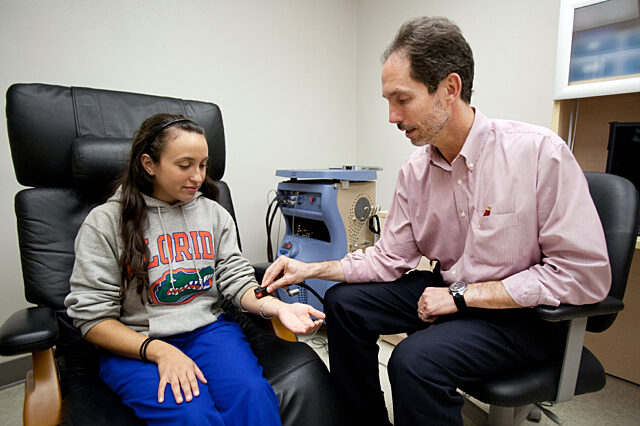Large-scale study sheds light on painful jaw disorder

Roger Fillingim, Ph.D., poses for a picture with Marissa Burns, a volunteer research assistant, in UF's OPPERA lab. The lab identifies risk factors for development of orofacial pain. (Photo by Maria Farias/University of Florida)
A large clinical study of painful jaw problems commonly known as TMD disorders has revealed a wide range of findings, including how women apparently grow more vulnerable to the condition as they age.
Writing in the November issue of the Journal of Pain, a multi-institutional team of researchers including scientists with the University of Florida College of Dentistry, revealed the results of the Orofacial Pain Prospective Evaluation and Risk Assessment study, or OPPERA.
One of the largest clinical investigations into the causes of what are technically known as temporomandibular joint disorders, or TMD, researchers hope the discoveries may lead to new methods of diagnosing and treating facial pain conditions, and predicting who will be susceptible to them.
“A major benefit of the OPPERA study is the comprehensive evaluation of demographic, clinical, biological, sensory and psychosocial factors that may contribute to increased risk of TMD,” said Roger Fillingim, Ph.D., a professor of community dentistry and behavioral science at the UF College of Dentistry and the principal investigator for the UF OPPERA site. “It is important to assess variables across these multiple biopsychosocial domains in order to fully reflect the complexity of chronic pain development and persistence.”
Temporomandibular joint disorders, sometimes referred to as TMJ, produce pain that radiates from the jaw and surrounding muscles, restricting jaw movement and causing considerable suffering. Although the disorders vary in duration and severity, for some people the pain becomes a permanent feature of their lives. Estimates suggest more than 10 million people are affected by TMD disorders, according to the National Institute of Dental and Craniofacial Research.
Researchers, led by William Maixner, D.D.S., of the University of North Carolina at Chapel Hill School of Dentistry, followed 3,200 initially pain-free individuals aged 18 to 44 for three to five years, comparing the initially pain-free individuals with 185 people who had long-standing, chronic TMD.
They found chronic TMD becomes more frequent with increasing age in women, but not in men. Early studies indicated women’s greatest risk occurred during early childbearing years and decreased thereafter.
In addition, a wide range of biological and psychological factors appear to contribute to the condition. Compared with pain-free individuals, people with TMD were much more sensitive to mildly painful sensations, they were more aware of body sensations and they experienced greater heart rate increases during mild physical and psychological stress.
Researchers believe the findings provide evidence that chronic TMD is at least partially linked to a person’s perception of and ability to suppress pain, which is determined by the body’s physiological regulatory systems.
Researchers also identified new and important genetic factors that appear to be linked to chronic TMD. Several genes, including some known to influence stress response, psychological well-being and inflammation were identified and may result in new targets for drugs to treat temporomandibular joint disorders and related chronic pain conditions.
The longitudinal study builds on earlier work by members of the multi-university research team, which designed a broad conceptual model to determine the condition’s causes.
“The OPPERA conceptual model proposes that measures of pain sensitivity and psychosocial functioning, both of which are influenced by life experiences as well as genetics, are related to future development of TMD,” Fillingim said. “While the OPPERA conceptual model was developed initially to explain risk for developing TMD, it can be more broadly applied and may help explain the reasons some people develop many different chronic pain conditions.”
The research team will publish additional findings and insights as they continue to analyze the study data.
The National Institute of Dental and Craniofacial Research-funded study was conducted across four study sites, including UF, UNC-Chapel Hill, UF, the University of Maryland at Baltimore, the University of Buffalo and Battelle Memorial Institute. The initial conceptual model of TMD causation was developed by Maixner, Luda Diachenko, Ph.D., Gary Slade, Ph.D., at UNC-Chapel Hill and Fillingim at UF.
Other study investigators include Eric Bair, Ph.D., and Shad Smith, Ph.D., from UNC; Ronald Dubner, D.D.S., Ph.D., and Joel D. Greenspan, Ph.D., from the University of Maryland; Richard Ohrbach, D.D.S., Ph.D., at the University of Buffalo; and Charles Knott with Battelle Memorial Institute, who served as the director of the Data Coordination Center.
About the author
